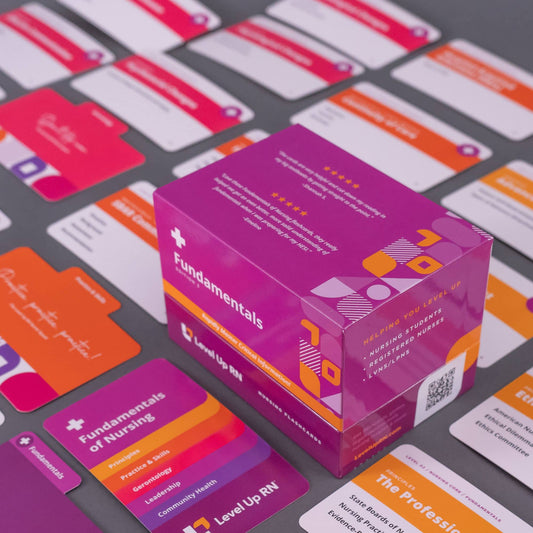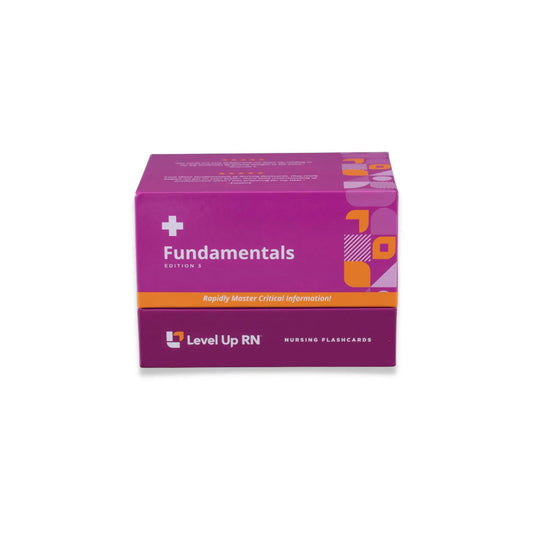This article covers fall prevention, both within the hospital and at home, and the use of restraints. You can follow along with our Fundamentals of Nursing flashcards, which are intended to help RN and PN nursing students study for nursing school exams, including the ATI, HESI, and NCLEX.
Fundamentals of Nursing - Flashcards
Fall prevention
Fall prevention is an important aspect of nurse training because patient falls can lead to injuries that will complicate their ability to recover and delay their discharge from care. If the patient is at home and suffers a fall, it’s possible they could be incapacitated and unable to receive the help they need, leading to greater trauma and even death.
Fall prevention in healthcare facilities
The following are some of the things nurses can do or look out for in order to prevent patient falls when the patient is in a healthcare facility or acute care facility.
Round hourly on your patients
Rounding hourly means checking regularly and frequently on how the patient is doing. Do they need anything? Are they getting regular opportunities for toileting and nutrition? Most important, check to make sure they are still in their bed.
Move the patient closer to the nurses’ station
If the patient is confused or unable to follow instructions, or if they have difficulties calling for assistance, move them so their room is closer to the nurses' station. This is an effective, non-invasive way to keep an eye on them.
Keep floors clean, dry, and uncluttered
Clean and uncluttered floors allow your patient to get out of bed and move about on their own, without having to step over items on the floor. Keeping the floor dry means an ambulatory patient can avoid slippery, dangerous, wet spots.
Ensure the patient's bed is always locked and set in the lowest position
A patient should be able to move easily onto and off of their bed if the need arises. So make sure the bed cannot move and is set to a height that makes it easy for the patient to access it.
Set the bed alarm for patients who are at a higher risk for falls
For patients who should not be ambulatory, setting an alarm that will go off in the nurses’ station will alert you when a patient gets out of bed on their own. You can then attend to them immediately.
Keep the patient's possessions within easy reach
Keep the patient's possessions — that is, anything they might need (water, their glasses, dentures) — on their overbed table or within easy reach of their bed. A patient who needs something may attempt to get out of bed unsupervised to retrieve that thing, which can lead to a fall. Make sure the call light is always placed within the patient's reach.
Have the patient wear non-slip footwear
If the patient does need to get up and move about, make sure they wear non-slip, well-fitting footwear. This is why hospital socks come with "grippy" soles.
Preventing orthostatic hypotension
Encourage the patient to sit on the edge of the bed and dangle their legs before standing up. This helps prevent orthostatic hypotension, a form of low blood pressure that happens when you stand up suddenly, which could lead to a fall. Having them dangle their legs before getting up will give their blood pressure a chance to catch up to the next move they want to make.
Fall prevention at home
Fall prevention is just as important for a patient who has returned home as it is for when they are under your direct care in the hospital.
There are several things patients or their families can do to prevent falls at home.
Removing scatter rugs
This is a simple and effective way to prevent falls. Small rugs can slip when stepped on. And their edges and corners can roll up, creating trip hazards.
Ensure good lighting
Make sure the patient's home has good lighting, especially over any stairs. Also, encourage the use of nightlights, to illuminate their path when it gets dark in the house.
Mark the edges of steps
Mark the edges of steps with colored or reflective tape, so they are easier to see. And remove clutter that could force the patient to have to step around, or over, anything.
Tape down electrical cords
Ideally, electrical cords should be run against or along a wall or behind furniture, in order to keep them out of the way. If this is not possible, tape them down so the entire cord is taped to the floor. Do not run an electrical cord under a rug or carpet, as this can become a trip hazard.
Install grab bars
Install grab bars in showers and bathtubs and place a non-slip mat on the shower floor.
And, as we have previously discussed, it is important to teach patients the proper use of assistive devices (e.g., grab bars, railings, walkers, canes).
Restraints
Restraints are means that restrict a patient's freedom and ability to move. Restraints are also covered from a psychiatric mental health nursing perspective in our Psychiatric Mental Health Nursing Flashcards!
Types of restraints
A restraint can be physical or chemical.
Physical restraints
Physical restraints are anything physically put on a patient's body. These include:
- Hand mitts: These are the least invasive type of physical restraint. They look like club-shaped oven mitts and they fasten at the wrist.
- Limb restraints: These look like padded cuffs with straps attached.
- Belts: These attach to a bed or other fixed structure.
- Vests: These are similar to belts but restrain the patient's chest or torso.
Patients have a right to the least restrictive environment. That means choosing the least restrictive restraints possible, often meaning hand mittens.
Chemical restraints
Medications can also be used as a restraint, as they can keep a patient sedated and/or calm. Benzodiazepines and antipsychotics are often administered as restraints.
Note that as with physical restraints, patients have certain rights when it comes to medications, namely the right to refuse medications or other therapies.
Order requirements for restraints
Order requirements for restraints require an in-person assessment by the provider within 24 hours of the restraint order, and restraint orders are only good for 24 hours at a time. That means that if the patient continues to need restraints, a new order must be given every 24 hours.
PRN, orders are not permitted. PRN means pro re nata, Latin for "take as needed." So an order saying "apply restraints as needed" cannot be written. Correct procedure demands that a patient is only restrained until restraints are no longer needed, upon which they are immediately discontinued. If the need arises for a new restraint order, the process begins again, with a new order necessary every 24 hours.
Restraints documentation
When having to restrain a patient, the documentation process is extremely important and includes the rationale for why the patient is in restraints and the time (how long) they have been in restraints.
Patient assessment findings are another part of the documentation process. What is the patient’s general well-being? Are they calm? Are they breathing? Has their condition improved, or do they still seem agitated?
It is also important to document what care was offered to the patient and what care was provided to the patient. These are two different things! For example, toileting, fluids, and range-of-motion exercises may have been offered, but perhaps the patient only received the ROM exercises and fluids, and declined toileting. All of this gets documented clearly in the patient's chart, including what times any care was given.
Nursing care for a patient in restraints
Restraints, their orders, and their documentation are key elements of nursing care, so it is incumbent on nurses to assess what is really required for the patient. That means choosing the best option, not necessarily the most restrictive. That is, start by assessing whether restraints can be avoided in the first place.
Alternatives to restraints
See if there are alternatives to restraints. For example, try to set clear boundaries that the patient can follow to keep them calm and engaged in their care. Other options include reducing stimuli or providing a diversion or distraction, like giving them a task (e.g., folding washcloths). Move the patient closer to the nurses' station or offer PRN medications (“administered as needed”) if that means avoiding restraints.
If restraints must be used, then choose the least restrictive method to correct the issue.
In an emergency, the nurse can apply restraints. Remember that the order needs to be obtained from the provider as soon as possible after the application of restraints.
How to tie a restraint
When using a physical restraint, it must be tied to a part of the bed frame that moves with the bed, and not to a part of the bed that moves independently (or not at all), like the side rail or head of the bed. Tying the restraint to something that does not move in tandem with the bed can cause unwanted tightening or loosening of the restraint when the bed is adjusted.
When tying a restraint, use a quick-release knot (slip knot). Make sure two fingers fit between the restraint and patient.
When using a belt restraint, place it over the patient’s gown or clothing, not directly across their skin.
Assessing the restrained patient
Assess the patient's status and behaviors every 15 minutes. This is a more frequent assessment than usual. The reason for such frequent assessment is to prevent positional asphyxia. Patients might fight against their restraints and twist or turn until they are in a position where they cannot breathe adequately. This can cause asphyxiation, which can lead to suffocation or even death.
Take vital signs, provide range-of-motion exercises, and offer fluids and toileting every two hours (or per facility policy) for a restrained patient.
Remove the restraints immediately, once the patient is no longer a danger to themselves or to others.
If checking on a patient requires removing restraints, provide the care by removing one restraint at a time. For example, to check skin integrity, take off one restraint, do a range-of-motion check and examine the skin, then replace that restraint. Next, remove the other restraint and assess the other side of the patient before replacing the restraint.
Never restrain a patient because it's convenient
Understanding restraints is an important part of nursing school and appears across many parts of training. Familiarity with restraints — and how and when to use them — is not only important to protect a patient's physical safety, but to protect the patient's legal rights. A patient should never have things done to them against their will, unless it is medically necessary because they are a threat to themselves or to others.


